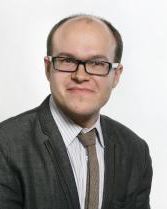Andrew Morris

Dr Andrew Morris
Senior Birmingham Fellow
Visitor
Email: ajm255 @ cam.ac.uk
Personal web site
TCM Group, Cavendish Laboratory
19 JJ Thomson Avenue,
Cambridge, CB3 0HE UK.
Research Group
- Dr Mihails Arhangelskis
- Dr Bora Karasulu
- Dr Joseph Nelson
- James Darby
- Matthew Evans
- Angela Harper
- Can Koçer Collaborators:
Dr Matthew Dunstan
Also:
Office: 2.90
The Maxwell Centre
JJ Thomson Avenue,
Cambridge.

Research
I am a Winton Advanced Research Fellow in the Cavendish Laboratory at The University of Cambridge. I am associated with both Nanoscience Centre and the Theory of Condensed Matter group.
My current interest is in applying the AIRSS method to a range of different materials science problems, focussing mainly on lithium-ion batteries. "Trial and error" plays a large part in the discovery of new materials. From the initial idea, the material must be synthesised and categorised before it can tested which is slow, difficult and expensive. High-throughput computation accelerates this process by suggesting then screening new materials, allowing us to ask "what if?" without the time and expense of manufacturing and categorizing samples. I model Li-ion batteries at the atomic level and try to uncover new materials to increase their capacity.
I use global search techniques such as ab initio random structure searching (AIRSS) to predict the ground-state structure of materials. From the ground state we use theoretical spectroscopy techniques to compare our results to experiment. As a junior developer of the electronic structure code CASTEP I develop tools for optics, electron-energy loss spectroscopy (EELS) and core-loss analysis through the OptaDOS code. I use and modify CASTEP-NMR to calculate the chemical shielding of battery materials in collaboration with experimentalists.
I am based in the Physics Department with strong links to the Chemistry Department and am currently looking for PhD and Part III project students.

In Plain English
I use theoretical methods to predict the behaviour of materials. . "Trial and error" plays a large part in the discovery of new materials. From the initial idea, the material must be synthesised and categorised before it can tested which is slow, difficult and expensive. High-throughput computation accelerates this process by suggesting then screening new materials, allowing us to ask "what if?" without the time and expense of manufacturing and categorizing samples. Currently I am interested in predicting the atomic structure of batteries. Which will then allow us to fully exploit their potential.
Featured Publications
- Halogen-bonded cocrystallization with phosphorus, arsenic and antimony acceptors. Nature Comm. 10 61 (2019)
- Strongly coloured thiocyanate frameworks with perovskite-analogue structures Chem. Sci. 10 793 - 801 (2019)
- Towards the systematic crystallisation of molecular ionic cocrystals: insights from computed crystal form landscapes. Faraday Disc. 211 401 - 424 (2018)
- Time-Dependent Density-Functional Theory for Modeling Solid-State Fluorescence Emission of Organic Multicomponent Crystals. J. Phys. Chem. A 122 7514 - 7521 (2018)
- Welcoming Gallium- and Indium-Fumarate MOFs to the Family: Synthesis, Comprehensive Characterization, Observation of Porous Hydrophobicity, and CO2 Dynamics. ACS Applied Materials and Interfaces 10 28582 - 28596 (2018)
- Erratum: Structure Prediction of Li-Sn and Li-Sb Intermetallics for Lithium-Ion Batteries Anodes (Chemistry of Materials (2017) 29:14 (5787?5795) DOI: 10.1021/acs.chemmater.6b04914) Chem. Mater. 30 5516 - 5517 (2018)